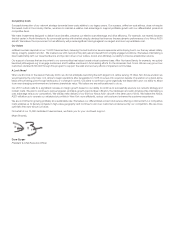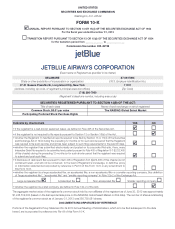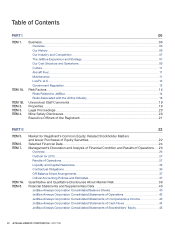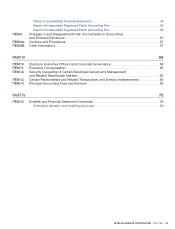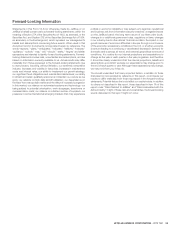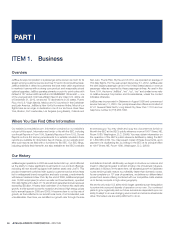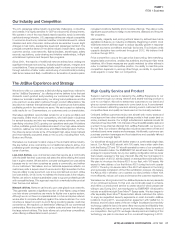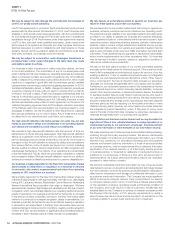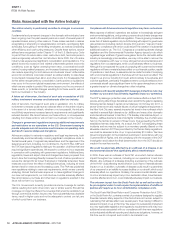JetBlue Airlines 2012 Annual Report Download - page 14
Download and view the complete annual report
Please find page 14 of the 2012 JetBlue Airlines annual report below. You can navigate through the pages in the report by either clicking on the pages listed below, or by using the keyword search tool below to find specific information within the annual report.JETBLUE AIRWAYS CORPORATION-2012 10K10
PART I
ITEM 1Business
Transportation System, or NextGen. By December 31, 2012, through a
government funded program, we had equipped 35 of our Airbus A320
aircraft with ADS-B Out. ADS-B Out is a satellite based technology aimed
to facilitate the communication between pilots and air traffi c controllers
thereby improving safety and operational effi ciency in this busy airspace.
We expect to begin initial testing in 2013. We anticipate that when the
technology is in place, average fl ight times will be reduced. Additionally, in
2012, we became the fi rst FAA certifi ed Airbus A320 carrier in the United
States to use satellite-based Special Required Navigation Performance
Authorization Required, or RNP AR, approaches at two of JFK’s prime
and most used runways, 13L and 13R. Given our signifi cant presence in
JFK, we believe the unique procedures associated with this technology
will provide for shorter fl ight times and reduced greenhouse emissions.
The highest concentration of our network and infrastructure is in the New
York metropolitan area, Boston and the Caribbean & Latin America region.
•
New York Metropolitan Area. We are New York’s Hometown Airline.
TM
Since 2000, the majority of our operations have originated in New York
City, the nation’s largest travel market and the largest U.S. point of entry
from international locations. We are the largest domestic airline at New
York’s John F. Kennedy International Airport, or JFK, as measured by
passengers and, by the end of 2012, our domestic operations at JFK
accounted for nearly 40% of all domestic passengers at this airport. In
addition to JFK, we serve Newark, NJ’s Liberty International Airport, New
York’s LaGuardia Airport, Newburgh, NY’s Stewart International Airport and
White Plains, NY’s Westchester County Airport. We are the leading carrier
in number of fl ights fl own per day between the New York metropolitan
area and Florida. JFK is New York’s largest airport, with an infrastructure
including four runways, large facilities and a direct light-rail connection
to the New York City subway system and the Long Island Rail Road.
In 2012, we began construction of T5i, an international arrivals facility,
which will expand our current Terminal 5, or T5, footprint. We believe
the new space will enable us to increase effi ciencies, provide savings
and streamline our operations and the overall customer experience.
•Boston. We are the largest carrier in terms of fl ights and seats offered
at Boston’s Logan International Airport, or Boston. Additionally, we serve
twice as many non-stop destinations from Boston than any other airline.
By the end of 2012, our domestic operations accounted for more than
20% of all domestic fl ights at this airport. We continue to capitalize on
opportunities in the changing competitive landscape by adding routes
and frequencies and increasing our relevance to local travelers, including
corporate travelers. These actions have resulted in signifi cant growth for
us over the past three years. During 2012, we continued to invest in our
Boston infrastructure including opening a new hangar to accommodate
our growing operations. We intend to continue to grow to 150 fl ights
per day from approximately 110 fl ights per day currently.
•
Caribbean and Latin America. A main driver of the growth of our route
network since 2008 has been through the addition of new destinations
in the Caribbean and Latin America. These markets have historically
matured more quickly in terms of cash break-even and profi tability than
mainland fl ights of comparable distances. As of December31, 2012,
approximately 27% of our capacity was in the Caribbean and Latin
America. We expect this number to continue to grow as we continue to
seize opportunities. VFR traffi c strongly complements leisure travel in the
Caribbean region allowing for our profi table growth and success in this
area of our network. Additionally, competitive landscape changes in San
Juan, Puerto Rico have allowed us to increase our presence there. We
continue to invest in our Caribbean operations, including introducing new
intra-Caribbean service out of Puerto Rico. We are the largest airline in
terms of capacity serving all of Puerto Rico. During 2012, we relocated to
an all new terminal in San Juan to accommodate our continued growth.
We currently serve approximately 35 fl ights per day in San Juan and
plan to continue to grow our operations to 50 fl ights per day. During
2012, we began offering service to and from our sixth destination in the
Dominican Republic, where we are also the largest airline in terms of
capacity. While the Caribbean and Latin American region is a growing
part of our network, operating in some of these developing countries can
present operational challenges, including working with less developed
airport authorities, political instability and increased civil disturbances.
Fleet
High aircraft utilization. By scheduling and operating our aircraft effi ciently
we are able to spread our fi xed costs over a greater number of fl ights and
available seat miles. For the year ended December31, 2012, our aircraft
operated an average of 11.8 hours per day which we believe is among
the highest of all major U.S. airlines. Our airport operations allow us to
schedule our aircraft with minimum ground time. We offer a signifi cant
percentage of overnight “red-eye” fl ights, which due to the limited ground
time presents us with maintenance challenges.
Aircraft reliability and effi ciency. We currently operate only two aircraft
types, the Airbus A320 and the EMBRAER 190. Reliability and durability
of our fl eet is essential to our operations running smoothly, and is critical
to delivering a superior experience for our customers. The average age
of our fl eet is 6.7 years, which we believe is one of the youngest of any
major U.S. airline. Operating a younger fl eet and incorporating the latest
technologies results in our aircraft being more effi cient and dependable
than older aircraft. We have the world’s largest fl eet of Airbus A320
aircraft. Of the large Airbus A320 operators in North America, we have
among the best dispatch reliability. We are continually working internally
and with our aircraft and engine manufacturers to enhance our reliability
and effi ciency metrics. Beginning in 2018, we expect to take delivery of
40 A320 new engine option, or A320neo, aircraft, which incorporate a
revolutionary engine design expected to increase fuel effi ciency by up to
16% compared to the current A320 design. Beginning in 2013, we plan
to equip our Airbus aircraft with curved extensions to the wings designed
to provide greater and cleaner aerodynamic lift, or sharklets. We expect
the sharklets will produce better fuel effi ciency for the aircraft, with up to
three percent less fuel burn on long-haul fl ights, providing for fuel savings
and range fl exibility. We expect to have 12 A320 aircraft equipped with
sharklets by the end of 2013.
Labor
Productive workforce. Our Crewmember effi ciency results from fl exible and
productive work rules resulting from the direct relationship between JetBlue
and its highly engaged Crewmembers. We fi rmly believe maintaining the
direct relationship with our Crewmembers is core to the JetBlue Culture we
have built since we began operations in 2000. We believe our non-union
workforce allows us increased fl exibility, which in turn allows us to adapt
more quickly in a changing environment. Our continued profi table growth
is dependent upon this ability to quickly adapt. Our pilots are among the
most productive in the U.S. passenger airline industry, ranking second in
average annual block hours per pilot. We also effectively use part-time
Crewmembers and automate tasks through the use of technology to gain
effi ciencies. We are cognizant of the competition for productive labor in
key industry positions. Additionally, new government rules requiring higher
qualifi cations are predicted to result in potential labor shortages in the
upcoming years. Through ongoing collaboration with peer-elected frontline
Crewmembers from our internal major work groups (which we refer to as
Values Committees), we ensure we have the input necessary to help us
manage and run the business in the most productive and effi cient way. We
continue to work closely with our Crewmembers and Values Committees
to ensure our Crewmembers remain engaged and productive.


